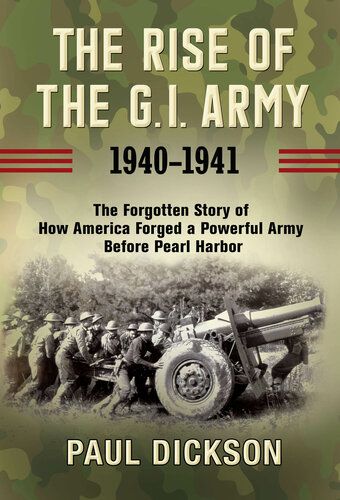
The Rise of the G.I. Army, 1940-1941
The Forgotten Story of How America Forged a Powerful Army Before Pearl Harbor
- اطلاعات
- نقد و بررسی
- دیدگاه کاربران
نقد و بررسی

April 15, 2020
A richly detailed history of the rebuilding of American military power in the run-up to World War II. In 1939, when Hitler invaded Poland, the U.S. Army had fewer than 120,000 men in uniform; Gen. Douglas MacArthur said they all could have fit into Yankee Stadium. Recognizing that war was all but inevitable, President Franklin Roosevelt took steps to revitalize the nation's military, and his most important move was likely the appointment of Gen. George Marshall as chief of staff of the Army. Marshall had been prepared for the job due to his leadership in the Depression-era Civilian Conservation Corps, in which young men learned discipline and skills that coincidentally prepared them for life in the Army. The CCC, writes Dickson, "became a driving force for improving the Army and facilitating the education and professional development of key officers." The establishment of a peacetime draft in 1940--against strong opposition from isolationists in Congress and elsewhere--was also a key element. Marshall gave the Army's officer corps a vital shot in the arm with his creation of Officer Candidate School, allowing talented men to rise to command positions without a degree from a traditional military academy. Dickson also highlights the war games that took place in 1941, especially a large exercise in Louisiana just before Pearl Harbor where both Dwight Eisenhower and George Patton proved their abilities. The author provides a wealth of fascinating detail; even those familiar with the general history of the period will learn something new. Especially intriguing are Dickson's discussions of the rise of the United Service Organizations, with shows headlined by Bob Hope and other stars, and the implications of a universal draft for black Americans. One of the best treatments to date of America's rapid transition from the Depression to the wartime power it became.
COPYRIGHT(2020) Kirkus Reviews, ALL RIGHTS RESERVED.

May 4, 2020
Historian Dickson (Leo Durocher: Baseball’s Prodigal Son) delivers an exhaustive chronicle of U.S. Army efforts to prepare for WWII. Noting that the army grew from less than 200,000 men to 4.5 million between the German invasion of Poland in September 1939 and the one-year anniversary of Pearl Harbor in December 1942, Dickson credits U.S. Army chief of staff George C. Marshall for tapping the Civilian Conservation Corps for seasoned officers, directing large-scale training exercises that tested the army’s expeditionary capabilities, and purging poor-performing generals from the ranks. Meanwhile, lawmakers overcame isolationist rhetoric to pass the first peacetime draft in American history, and then extend the minimum term of duty from 12 to 30 months. Dickson also documents the contributions of generals including Omar Bradley, George Patton, and Dwight Eisenhower; preparations for the invasion of North Africa in November 1942; and frustrations of African-American soldiers fighting in a segregated army. Dickson marches readers through his voluminous research at a brisk clip, and makes a convincing case that if the army hadn’t been transformed, the war would have been lost. WWII buffs and military history readers will salute this stirring effort.

June 1, 2020
The years leading up to U.S. involvement in World War II included instrumental efforts in preparing military forces for the war. In October 1940, the first men were drafted into military service. Conscription prior to the Pearl Harbor attacks, and the various programs and training operations before and during this period, are the focus of Dickson's (Sputnik) latest work. During the Depression era, the Civilian Conservation Corps gave purpose to a considerable number of men, many of whom would later serve in the armed forces. The 1941 training maneuvers, in which large infantry and motorized forces squared off against one another in states, such as Tennessee and Louisiana, were vital in the education and preparation of American troops. Dickson notes the lessons learned about soldiers' levels of fitness and nourishment, morale, logistics, special operations, and even deaths caused by training accidents. Entertainment and the development of G.I. culture are mentioned, as well as a discussion of racial integration following World War II. VERDICT A gripping study of a topic less explored, this work should appeal to readers interested in pre-World War II preparations and social and cultural aspects of U.S. Army history.--Matthew Wayman, Pennsylvania State Univ. Lib., Schuylkill Haven
Copyright 2020 Library Journal, LLC Used with permission.




دیدگاه کاربران